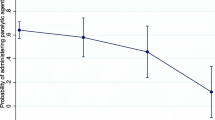Abstract
Background
We previously have shown that there was a strong correlation between failed facemask ventilation, failed ventilation through a supraglottic airway, and difficult tracheal intubation. The primary aim of this study was to evaluate whether or not an established method to predict difficult ventilation through a supraglottic airway was also useful for predicting failed facemask ventilation.
Methods
This was a single-center, retrospective observational study. We studied 28,081 anesthetized patients in whom ventilation through a facemask, and supraglottic airway was attempted as the initial technique during induction of anesthesia, between May 2011 and March 2016. For each patient, the score which had been validated to be useful for predicting difficult ventilation through a supraglottic airway was calculated. The score ranged between 0 and 7 points, and we defined a low risk when the score was 0–3, and a high risk when the score was 4–7. To measure and compare the predictive accuracy of the score, we generated a receiver operating characteristic curve and compared the area under the curve (AUC).
Results
The incidence of failed facemask ventilation was significantly higher in patients with high-risk predictive score than in patients with low-risk predictive score [0.38% vs 0.056%, odds ratio 6.8 (95% CI 2.6–18.1, p value = 0.002)], and the sensitivity of the score was 25%, while the specificity was 95%, with a negative predictive value of 99%. The AUC of the score was 0.71 (95% CI 0.58–0.83).
Conclusions
The predictive score for difficult ventilation through a supraglottic airway is also useful to predict failed facemask ventilation.



Similar content being viewed by others
References
Apfelbaum JL, Hagberg CA, Caplan RA, Blitt CD, Connis RT, Nickinovich DG, Hagberg CA, Caplan RA, Benumof JL, Berry FA, Blitt CD, Bode RH, Cheney FW, Connis RT, Guidry OF, Nickinovich DG, American Society of Anesthesiologists Task Force on Management of the Difficult Airway. Ovassapian A Practice guidelines for management of the difficult airway: an updated report by the American Society of Anesthesiologists Task Force on Management of the Difficult Airway. Anesthesiology. 2013;118:251–70.
Frerk C, Mitchell VS, McNarry AF, Mendonca C, Bhagrath R, Patel A, O'Sullivan EP, Woodall NM, Ahmad I, Difficult Airway Society Intubation Guidelines Working Group. Difficult Airway Society 2015 guidelines for management of unanticipated difficult intubation in adults. Br J Anaesth. 2015;115:827–48.
Cook TM, Woodall N, Frerk C. Major complication of airway management in the UK: results of the Fourth National Audit Project of the Royal College of Anaesthetists and the Difficult Airway Society. Part 1: anaesthesia. Br J Anaesth. 2011;106:617–31.
Japanese Society of Anesthesiologists. JSA airway management guideline 2014: to improve the safety of induction of anesthesia. J Anesth. 2014;28:482–93.
Yildiz TS, Solak M, Toker K. The incidence and risk factors of difficult mask ventilation. J Anesth. 2005;19:7–11.
Kheterpal S, Han R, Tremper KK, Shanks A, Tait AR, O’Reilly M, Ludwig TA. Incidence and predictors of difficult and impossible mask ventilation. Anesthesiology. 2006;105:885–91.
Kheterpal S, Martin L, Shanks AM, Tremper KK. Prediction of impossible mask ventilation: a review of 50,000 anesthetics. Anesthesiology. 2009;110:891–7.
El-Orbany M, Woehick HJ. Difficult mask ventilation. Anesth Analg. 2009;109:1870–80.
Asai T, Morris S. The laryngeal mask airway: its feature, effects and role. Can J Anaesth. 1994;41:930–60.
Ramachandran SK, Mathis MR, Tremper KK, Shanks AM, Kheterpal S. Predictors and clinical outcomes from failed Laryngeal Mask Airway UniqueTM: a study of 15,795 patients. Anesthesiology. 2012;116:1217–26.
Saito T, Liu W, Chew ST, Ti LK. Incidence of and risk factors for difficult ventilation via a supraglottic airway device in a population of 14,480 patients from South-East Asia. Anaesthesia. 2015;70:1079–83.
Saito T, Chew ST, Liu WL, Thinn KK, Asai T, Ti LK. A proposal for a new scoring system to predict difficult ventilation through a supraglottic airway. Br J Anaesth. 2016;117(Suppl 1):i83–i86.
Saito T, Asai T, Taguchi A, Chew ST, Liu WL, Thinn KK, Ti LK. Correlation between failed facemask ventilation, failed ventilation through a supraglottic airway and difficult tracheal intubation in unanticipated difficult airways: an observational study. J Clin Anesth. 2020;60:34–5.
Saito T, Wong ZW, Thinn KK, Poon KH, Liu E. Review of critical incidents in a university department of anaesthesia. Anaesth Intensive Care. 2015;43:238–43.
Swets JA. Measuring the accuracy of diagnostic systems. Science (New York NY). 1988;240:1285–93.
Yentis SM. Predicting difficult tracheal intubation: worthwhile exercise or pointless ritual? Anaesthesia. 2002;57:105–9.
Asai T. Complications with supraglottic airways: something to worry about or much ado about nothing? Anesthesiology. 2012;116:1183–5.
Asai T. Strategies for difficult airway management—the current state is not ideal. J Anesth. 2013;27:157–60.
Asai T. Progress in difficult airway management. J Anesth. 2017;31:483–6.
Acknowledgements
We thank the staff of the Department of Anesthesia, National University Health System and Yong Loo Lin School of Medicine, National University of Singapore, for their contribution to this study.
Author information
Authors and Affiliations
Corresponding author
Additional information
Publisher's Note
Springer Nature remains neutral with regard to jurisdictional claims in published maps and institutional affiliations.
About this article
Cite this article
Saito, T., Asai, T., Taguchi, A. et al. Prediction of failed facemask ventilation: new scoring system for difficult airway. J Anesth 34, 367–372 (2020). https://doi.org/10.1007/s00540-020-02761-3
Received:
Accepted:
Published:
Issue Date:
DOI: https://doi.org/10.1007/s00540-020-02761-3




